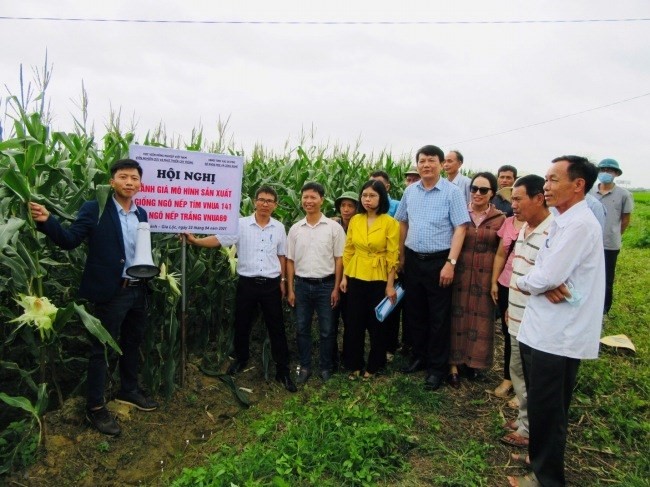October 10, 2025 | 02:41 GMT +7
October 10, 2025 | 02:41 GMT +7
Hotline: 0913.378.918
October 10, 2025 | 02:41 GMT +7
Hotline: 0913.378.918
The Crop Research and Development Institute (CRDI) under Vietnam National Academy of Agriculture in coordination with Gia Khanh Agricultural Service Cooperative have held a meeting to evaluate a production model for anthocyamin-rich purple sticky corn VNUA 141 and white sticky corn VNUA 69 in Gia Khanh commune in Hai Duong province’s Gia Loc district.
The CRDI was assigned by Hai Duong Province’s Department of Science and Technology to build a model of producing purple sticky maize varieties which are rich in anthocyamin in the province for 2020-2021 period.
VNUA 141 and VNUA 69 varieties showed the advantages of hybrid breeding programs as both varieties grow well in the fourth growing cycles. VNUA 141 and VNUA 69 have shorter harvest time of fresh corn than check varieties HN88 and Fancy 111. VNUA 141 have highly fresh yield, from 93.44 to 94.62 quintals per ha in spring season and 84.63 quintals per ha in autumn /winter seasons that is lower than check variety HN88.

A production model of white sticky maize VNUA 69 in the 2021 spring crop at Gia Khanh Commune in Hai Duong Province’s Gia Loc District. Photo: VAN.
Profit from growing purple sticky corn VNUA 141 reached VND33-35 million (US$1,430-1,518) per hectare, an increase of 23 per cent compared to check variety Fancy 111.
The profit from planting white sticky corn VNUA 69 is estimated at VND46-50 million per ha, a 18-22 per cent hike in comparison with HN88.
Farmers can earn VND1.2-1.8 million (US$52-78) per sao (one sao equals to 360sq.m), much higher than rice cultivation.
Both VNUA 141 and VNUA 69 varieties prove to be highly resistant to maydis leaf spot disease than check varieties.
Nguyen Duc Doan, director of Gia Khanh Agricultural Services Cooperative, said heavy rains and strong winds had caused maize to fall during the 2021 spring crop. However, VNUA 141 and VNUA 69 varieties were still distinct from the other varieties within the same species. Specifically, they are more productive and adaptive than the check variety, resulting in the fact that their seeds and productivity are much higher than the others.
In addition, the leaves of the two varieties are green and disease-free so local farmers could use them as animal feed.
Tang Thi Hanh, deputy head of Gia Loc District’s Agriculture and Rural Development Sub-department, appreciated the two varieties.
“Local farmers are excited because they can still sell maize at VND10,000-12,000 (43-52 US cents) per kilogram while the price of other crops in the locality kept falling,” she said.
She hoped that in the future scientists of Vietnam National Academy of Agriculture would continue to breed maize varieties with good adaptability, productivity and high quality so that localities could experiment and put them into production, bringing stable income for farmers.
Doctor Nguyen Van Muoi, Deputy Director of CRDI said that two hybrid sticky corn varieties VNUA 141 and VNUA 69 are suitable for the soil conditions in Hai Duong Province.
It is shown in their growth ability and strong resilient to unfavourable conditions over four consecutive crops, he said, adding that the two varieties have been planted on 20ha of land in Gia Khanh Commune (Gia Loc District), An Thanh (Tu Ky District), Tan Trao (Thanh Mien District) and Tan Dan (Chi Linh City) in 2021 spring crop.
Muoi suggested Hai Duong Province to expand the planting areas to meet the demand of the market in the future.
Translated by Mai Hien

(VAN) Cassava mosaic disease is wreaking havoc on cassava crops, prompting scientists to develop resistant varieties using molecular marker technology - a breakthrough that could pave the way for the sustainable development of the industry.

(VAN) After detecting an H5N1 avian influenza outbreak, Khanh Hoa Department of Agriculture and Environment promptly implemented disease prevention measures.

(VAN) The Ministry of Agriculture and Environment has requested Nghe An to expedite the disbursement of ERPA funds, avoid backlogs, ensure the rights of forest owners, and promote sustainable forest development.

(VAN) Operating a European-standard refrigeration system at full force, Thanh Bao Han poultry slaughterhouse ensures tens of thousands of safe meals every day.

(VAN) Large timber is the foundation for elevating the wood processing and export industry, and community-based agricultural extension acts as the forestry sector's 'extended arm'.

(VAN) An Giang is capitalizing on its maritime advantages: high-tech aquaculture, marine tourism, and renewable energy, which are becoming pillars of the marine economic development.

(VAN) From household groups to cooperatives practicing sustainable forest management, local communities are contributing to the expansion of forest certification, helping Vietnam's wood industry overcome international market barriers.